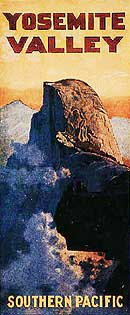April 28, 2001
Smokey The Bear
Where
there's Smokey, there's fire prevention!
Yosemite News Editorial Staff
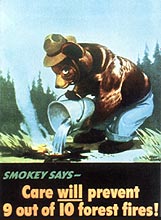 YOSEMITE
-- More than half a century has passed since Smokey Bear first cautioned
America to be careful with fire while enjoying the forest. The idea
of preventing carelessly caused wildfires came long before the real
bear's time. Wildfire safety quickly grew into necessity. With the
advent of World War II, America feared that an enemy attack or sabotage
could destroy our forest resources at a time when wood products
were greatly needed for the war effort. YOSEMITE
-- More than half a century has passed since Smokey Bear first cautioned
America to be careful with fire while enjoying the forest. The idea
of preventing carelessly caused wildfires came long before the real
bear's time. Wildfire safety quickly grew into necessity. With the
advent of World War II, America feared that an enemy attack or sabotage
could destroy our forest resources at a time when wood products
were greatly needed for the war effort.
As a result of this concern, the USDA
Forest Service organized the Cooperative Forest Fire Prevention
Program in 1942. It encouraged citizens nationwide to make a personal
effort to prevent forest fires. To help convey the concept to the
public, the Forest Service asked the War Advertising Council for
assistance. This newly formed group of advertisers volunteered their
time, expertise, and portions of their media schedules to help the
government mobilize civilian support for the war effort.
The council recognized the importance
of protecting our forest from fire and began a campaign that encouraged
people to assist the war effort by doing what they could to prevent
forest fires. Timber was, after all, a primary commodity for battleships,
gunstocks, and packing crates for military transport.
In 1944, the council produced a poster
featuring Walt
Disney's "Bambi" character. The success of this poster
demonstrated that an animal of the forest was the best messenger
to promote the prevention of accidental forest fires. On August
2, 1944, the Forest Service and the War Advertising Council introduced
a bear as the campaign symbol. This bear was to be black or brown
and his expression intelligent, appealing, and slightly quizzical.
To look his part, he would wear a traditional campaign hat.
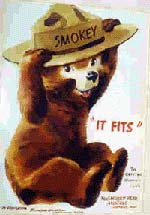 Albert
Staehle, noted illustrator of animals, worked with this description
to paint the forest fire prevention bear. His art appeared in the
1945 campaign, and the advertising symbol was given the name "Smokey
Bear." This first poster carried the caption: "Smokey
says: Care will prevent 9 out of 10 forest fires." Albert
Staehle, noted illustrator of animals, worked with this description
to paint the forest fire prevention bear. His art appeared in the
1945 campaign, and the advertising symbol was given the name "Smokey
Bear." This first poster carried the caption: "Smokey
says: Care will prevent 9 out of 10 forest fires."
As the campaign grew, Smokey reached
out to Americans from posters and roadside billboards, from the
pages of magazines and newspapers, and over the air from hundreds
of broadcasting stations. Many major corporations donated valuable
advertising time and space. The result was great success for the
Smokey Bear symbol and a decrease in accidental, human-caused forest
fires.
After World War II, the War Advertising
Council changed its name to The
Advertising Council. In the years that followed, the focus of
Smokey's campaign broadened to appeal to children as well as adults.
The earliest
pictures of Smokey Bear varied in appearance form year to year,
but his confident, friendly manner and the good sense of his fire
prevention message were always there.
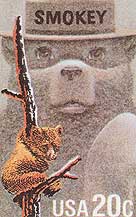 It
was not until the work of Chuck Kuderna, during the 1965 campaign,
that Smokey's image evolved into the one we know today. It
was not until the work of Chuck Kuderna, during the 1965 campaign,
that Smokey's image evolved into the one we know today.
In addition to the public service
advertising campaign, there were other needs for original art in
the CFFP Program. In 1946, Rudy Wendelin, an artist for the Forest
Service, began producing a tremendous quantity of Smokey Bear art
in various media for special events, publications, and licensed
products to promote the fire prevention symbol. Long after retiring,
he created the art for the Smokey Bear's 40th anniversary commemorative
U.S. Postage stamp. In Forest Service circles he is still know affectionately
as "Smokey's artist."
A significant chapter in Smokey's
long history began early in 1950, when a burned cub survived a fire
in the Lincoln
National Forest near Capitan, New Mexico. Because this bear
survived a terrible forest fire and won the love and imagination
of the American public, many people mistakenly believe the cub was
the original Smokey Bear, but in reality he did not come along until
the advertising symbol was almost six years old.
After being nursed back to health,
Smokey came to live at the National
Zoo in Washington, D.C., as a living counterpart to the CFFP
Program's fire prevention symbol.
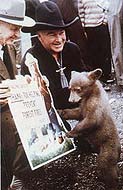 Over
the years, thousands of people from around the world, including
dignitaries and movie stars, came to see Smokey Bear at the National
Zoo. A mate, Goldie, was introduced with the hope a young Smokey
would continue the tradition of the famous living symbol. These
efforts failed and an adopted son was sent to the zoo so the aged
bear could retire on May 2, 1975. Over
the years, thousands of people from around the world, including
dignitaries and movie stars, came to see Smokey Bear at the National
Zoo. A mate, Goldie, was introduced with the hope a young Smokey
would continue the tradition of the famous living symbol. These
efforts failed and an adopted son was sent to the zoo so the aged
bear could retire on May 2, 1975.
After many years of popularity, the
original Smokey died in 1976. His remains were returned to Capitan
and rest beneath a stone marker in Smokey
Bear State Park. For more than 15 years, the adopted Smokey
carried on as the living symbol, but in 1990, when the second Smokey
Bear died, the living symbol was laid to rest.
Smokey's task is becoming increasingly
difficult. In years past, it was a challenge for his message to
reach traditional visitors to the forest. Now we are faced with
getting his wildfire prevention
message to an increasing number of people who live in and around
these areas. This "wildland-urban interface" poses a double
threat; from people living in or near forests who may accidentally
start fires that spread to the wildlands as well as from accidental
fires started in the wild that spread to nearby residences. In either
case, the result is potentially disastrous but especially tragic
because it is preventable.
The challenge continues as Smokey
Bear passes the half-century mark and enters the new millennium.
Demand for our natural resources continues to grow as does the population
of forested areas. In the future, the need to prevent accidental
wildfire will be greater than ever.
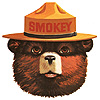
Remember...only YOU can prevent forest fires!
Letter
to the Editor

|






